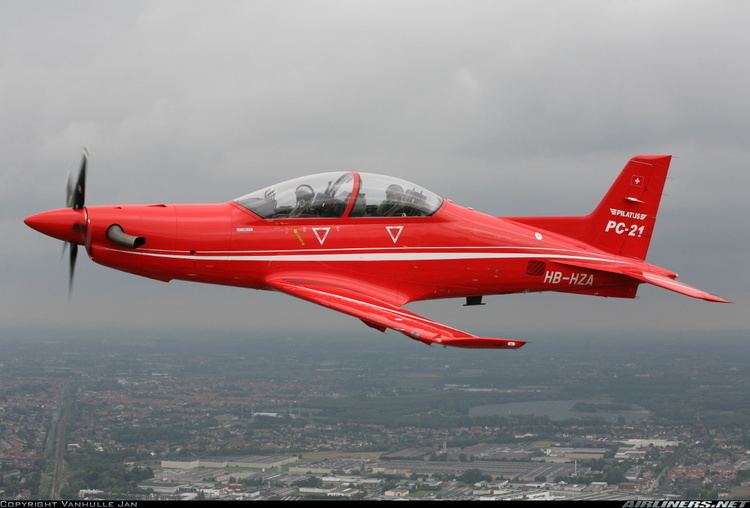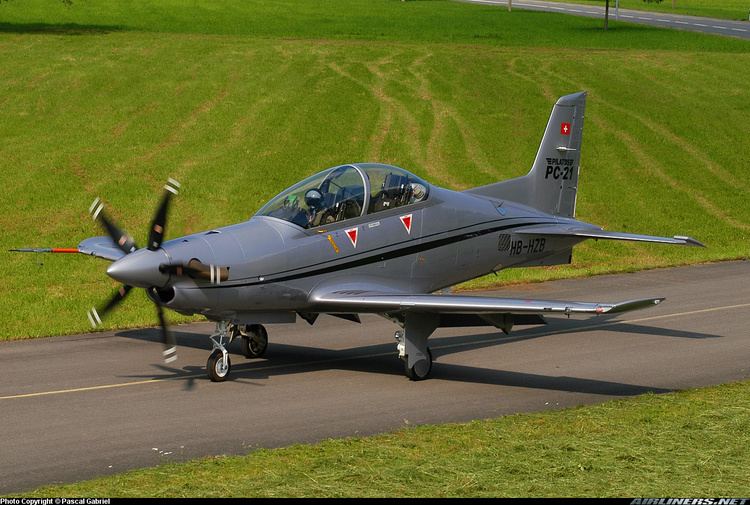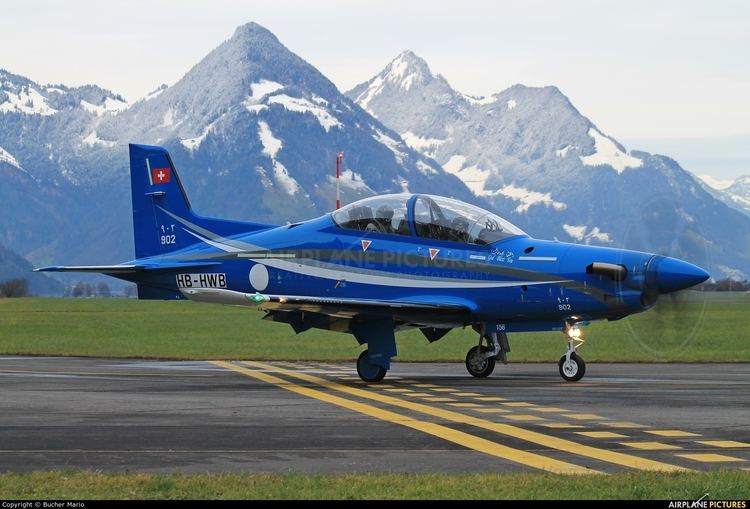Top speed 685 km/h Wingspan 9.12 m Length 11 m | Range 1,333 km Cruise speed 593 km/h Weight 2,270 kg | |
 | ||
Engine type Pratt & Whitney Canada PT6 | ||
Pilatus pc 21 rc scale turboprop model aircraft jetpower fair 2016
The Pilatus PC-21 is a single-turboprop, low-wing swept monoplane advanced trainer with a stepped tandem cockpit manufactured by Pilatus Aircraft of Switzerland.
Contents
- Pilatus pc 21 rc scale turboprop model aircraft jetpower fair 2016
- Pilatus pc 21 rc scale turboprop model aircraft trainer jetpower messe 2015
- Development
- Design
- Operational history
- Operators
- Specifications PC 21
- References

Pilatus pc 21 rc scale turboprop model aircraft trainer jetpower messe 2015
Development

In November 1997, Pilatus flew a modified PC-7 Mk.II in order to test improvements for a prospective next generation turboprop trainer. As a result of these tests, Pilatus elected to fund the development of a new training system in November 1998; development of the new trainer, designated as the PC-21, formally started in January 1999. The PC-21 would be developed and certified as a completely new training system, aimed at meeting future military customers' specifications in terms of capability and life-cycle costs for the next three decades.

A key aim for the PC-21 was to allow jet aircraft pilots to perform the majority of the training using the type, converting to jet-powered types only much later than typical contemporary practice, allowing operators to make substantial savings; in order to achieve this aim, the new trainer was required to have an expanded performance envelope in terms of aerodynamics, cockpit equipment, flexibility, and ease of maintenance. In May 2002, Pilatus announced that it aimed for the PC-21 to capture 50% of the global trainer aircraft market between 2005 and 2030.

From the start of the aircraft's development, Pilatus aimed for the type to have a predictable cost profile over its full lifespan. To meet this goal, the firm chose to incorporate modern materials, an innovative design concept, and full-scale fatigue analysis. Additionally, accompanying the aircraft itself are integrated training systems to meet the pilot's needs; the full package offered by Pilatus includes synthetic training devices, computer-based training, and classroom instruction. As a result of greater training effectiveness, pilots can graduate with fewer total training hours, reaching the frontline faster and at lower cost. In addition to pilots, various prospective aircrew, such as navigators, weapons officers, and electronic warfare operators, can be trained using the type's embedded simulation/emulation system.

On 30 April 2002, the rollout of the first PC-21 prototype was performed at Pilatus' factory in Stans, Switzerland; this aircraft conducted its first flight on 1 July of the same year. In May 2003, Pilatus management formally green-lit the program to proceed to full development. On 7 June 2004, a second PC-21 prototype, the construction of which having been delayed to incorporate improvements learnt from assembling the first, made its maiden flight. In December 2004, Switzerland's Federal Office for Civil Aviation granted type certification for the PC-21; civil certification was attained despite it being a military aircraft as this permitted civil maintenance procedures to be used as well as allowing the aircraft to be supplied under private finance arrangements. Individual Swiss military certification for equipment such as ejection seats has been applied as necessary.
On 13 January 2005, the second of the two development aircraft crashed in Buochs, Switzerland while conducting an aerobatic training flight; the accident resulted in the death of the pilot as well as injuring another person on the ground. In response to the incident, all PC-21 prototypes were grounded until 1 February 2005, by which point Swiss authorities had established that there was no sign of technical malfunction. In August 2006, it was announced that crash investigators had concluded that pilot error had been to blame for the accident in January 2005. In late August 2005, the first pre-series production PC-21 performed its maiden flight.
Design
The Pilatus PC-21 is an advanced single-engine trainer aircraft; it is often referred to by Pilatus as being the "Twenty-first Century Trainer". The type can be applied for various training capacities, including basic flying training, advanced flight training, full mission management training, and embedded simulation/emulation. In order to perform these functions, the aircraft possesses a powerful, flexible, and cost-effective integrated training system; providing sufficient ease of use for inexperienced pilots while posing greater challenge to advanced pilots. According to Pilatus, upon product launch, the PC-21 possessed "superior aerodynamic performance when compared with any other turboprop trainer on the market".
The aircraft features a tandem-seating arrangement (student in-front/instructor behind) in a bird strike-resistant glass canopy with allround vision. The cabin, which is pressurized, is equipped with an On-Board Oxygen Generation System (OBOGS), air conditioning, and Martin-Baker CH16C Zero-Zero ejector seats. The flight controls, which are fully balanced and harmonized, are optimized for easy of operation and overall effectiveness. An anti-g system is also present in order to minimize the effects of high g-forces experienced during tactical training and aerobatic maneuvers. Pilots are able to spend a greater amount of time concentrating on the aircraft's external situation and upon mission data inputs due to an ergonomic design approach, ease-of-use controls, and clear visual/system data displays. In addition, a full autopilot and civil flight management system are also present.
The PC-21 is powered by a single 1,600 shaft horse power Pratt & Whitney Canada PT6A-68B turboprop engine, which drives a five-bladed graphite Hartzell scimitar propeller on the aircraft's nose; it has been claimed by Pilatus that the PC-21 possesses speed and climb rates previously normally performed only by jet-powered aircraft. It is also fitted with a high-speed profile wing, rated for maneuvers up to 8 g, complete with hyraulically-assisted ailerons and spoilers which enable the execution of fighter-like rates of roll and other maneuvers. In order to make the aircraft easy to fly at low speeds, crucial to the advanced trainer role, the PC-21 is furnished with a digital power management system and the horizontal stabilizer is equipped with an automatic yaw compensator/suppression system to compensate for engine power and speed changes.
A key feature of the PC-21 is the embedded simulation and training suite, which provides cross-platform cockpit emulation, weapons simulation, stores management system, simulated radar and electronic warfare, a tactical situation display, and data link functionality. Key to this is the Mission Support System (MSS), which comprises the Mission Planning System (MPS) and Mission Debriefing System (MBS); data can be loaded and unloaded from these, which is compatible with ground-based stations for pre-flight configuration or post-mission analysis. The integrated mission computer is of an open architecture, allowing for third-party modifications and upgrades to take place; software can also be customized to conform to customer preferences. Critical and non-critical software are also deliberately separated.
The cockpit of the PC-21 features a high level of systems integration and conforms to modern avionics standards. The systems of the forward and rear cockpits can be 'de-coupled' between the student and instructor; the instructor may exercise real-time manipulation of the student's displays, sensor performance, and system modes such as to create synthetic air-to-air radar targets, artificial non-safety critical system failures, and controlled data degradation. The aircraft's fully digital glass cockpit features three large colour liquid crystal displays (LCD), one performing as the primary flight display (PFD) and two multi-function displays (MFDs) for system/mission management, in addition to CMC Electronics-provided head-up displays (HUD) for both the pilot and instructor. The trim gauge is the only analogue dial in the cockpit. For control simplicity, a Hands on Throttle and Stick (HOTAS) control philosophy has been followed. Both the display and control systems present also resemble their counterparts used upon modern front-line combat aircraft for greater realism during training; and can be further customized in order to be more representative of specific combat aircraft. The multi-sensor navigation system is capable of operating under a military tactical mode as well as a civil navigation mode.
Operational history
In the Armament Program 2006, the Swiss Parliament approved an initial purchase of the PC-21 for the Swiss Air Force. By April 2008, four PC-21 have been taken over by the Swiss Air Force following the passing of acceptance trials, and flight operations were set to start in July that year. In December 2010, the Swiss Air Force placed an order for another two aircraft.
In November 2006, the Republic of Singapore Air Force (RSAF) awarded a service contract to Lockheed Martin Simulation, Training and Support (LMSTS) to deliver 19 PC-21 aircraft, to support the RSAF's Basic Wings training course in Pearce, Australia under a public–private partnership (PPP) arrangement, replacing the SIAI-Marchetti S.211. Singapore was the first export customer for the PC-21. On 21 January 2008, the first RSAF PC-21 completed its flight test prior to being accepted into service. On 13 July 2008, the type began to provide the RSAF with basic flying training, by which point a further six aircraft had been delivered.
During the 2009 Dubai Airshow, the United Arab Emirates announced an order of 25 PC-21 trainers for the United Arab Emirates Air Force (UAEAF) to replace their aging fleet of Pilatus PC-7s. On 22 November 2010, the UAEAF's first PC-21 performed its maiden flight. In July 2012, it was announced that the Qatar Air Force had placed an order for a complete pilot training system from Pilatus centering upon the PC-21. The package included ground-based training devices, logistical support and maintenance in addition to 24 PC-21 aircraft. On 1 October 2014, the Qatar Air Force formally received its first batch of PC-21 trainers.
On 23 May 2012, Saudi Arabia signed a £1.6 billion ($2.5 billion) for a comprehensive next-generation military pilot training system, comprising 22 BAE Systems Hawk advanced jet trainers in addition to 55 PC-21 trainers. In early June 2014, Pilatus commenced delivery of the first six PC-21s to Saudi Arabia; by the end of 2015, this had risen to 46 PC-21s delivered.
The PC-21 was one of the submissions for the Royal Australian Air Force's project AIR 5428, which sought a replacement of its Pilatus PC-9s; in September 2015, it was announced that the consortium comprising Lockheed Martin, Pilatus and Hawker Pacific ("Team 21"), had won the bid to provide 49 PC-21s to the Australian Defence Force. Moreover, the PC-21 has been evaluated by the Spanish Air Force, along the T-6 Texan II and the PZL-130 Orlik III, as a possible substitute for its ENAER T-35 Pillan and CASA C-101 Aviojet trainer aircraft.
In August 2015, Pilatus received a contract to deliver nine PC-9Ms to the Royal Jordanian Air Force, but in April 2016 changed the order to eight PC-21s. Deliveries were due to start in January 2017 under the original deal.
In January 2017, Pilatus received a contract for 17 PC-21 by French department of defense as a new training aircraft.
Operators
Specifications (PC-21)
Data from Pilatus Aircraft
General characteristics
Performance
Armament
